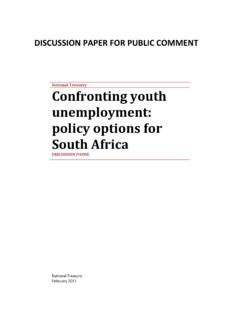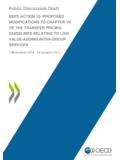Transcription of Retirement Fund Reform A Discussion Paper - …
1 NATIONAL TREASURY REPUBLIC OF SOUTH AFRICA Retirement fund Reform a Discussion Paper December 2004 2 CONTENTS Page Principles of Retirement Reform Objectives of Retirement Funding Policy 4 Modernisation and Reform the South African Retirement funding landscape 5 Access, Compulsion and Preservation 5 Benefits, Contribution Rates and Member Protection 6 fund Governance and Regulation 7 Conclusion 9 Annexure 1: The South African Retirement fund Landscape Introduction 10 The Three Pillars of a Retirement Funding System 11 Employment and Coverage 12 Contribution Rates and Costs 13 Replacement Rates 14 Leakage 16 Interaction With Social Old Age Pension 16 Summary 17 Annexure 2: Access, Compulsion, and Preservation Compulsion 18 National Savings fund 20 Differentiation 23 Individual Retirement Funds 26 Resulting Environment 27 Ancillary Benefits 27 Annexure 3.
2 Benefits, Contribution Rates and Member Protection Adequacy of Retirement Benefit 30 Pension Increases 32 Benefits Available 33 Minimum Rates of Contribution 35 Fluctuating Rates of Contribution 35 Form of Benefit 36 Post Retirement Medical Funding 37 Leakage 38 Minimum Benefits 38 Loss of Employment 38 Preservation and Portability 39 Interest on Late Payment of Benefits 40 Unclaimed Benefits 40 Access to Retirement Savings During Employment 41 Housing Loans and Guarantees 41 Other Life Crisis Needs 43 Deductions 44 Divorce 45 3 Payment of Benefits on Death 46 Payment of Benefits on Disability 47 Annexure 4: Governance and Regulation Powers of the Regulator 49 Statistical Reporting by Funds 53 Member Protection 53 Dispute Resolution 54 Governance and Trustee Conduct 55 Intersection of Labour Law and Pensions Law 61 Investment Regulation 63 Funding and Calculation Techniques 67 Winding Up 68 Bibliography 70 4 PRINCIPLES OF Retirement Reform Objectives of Retirement funding policy The organisation and financing of income security in Retirement is amongst the most profound expressions of a nation s cohesion and values.
3 It relies on confidence in the long-term continuity of institutions, it rests on trust in the law and sound financial and economic management, it embodies principles of solidarity, risk-sharing and prudential foresight. The South African Retirement fund industry has been heavily influenced by a racially divided past and the parallel existence of developed and emerging components of our economy. There is a large and well-established private contractual savings sector, government employees are provided for through a near-fully funded Retirement arrangement, but approximately three-quarters of the population reach Retirement age without a funded pension benefit and hence rely on a government social assistance grant programme. Though there are features of the structure and depth of the South African Retirement funding environment that compare well with both developed and developing countries, there are also decidedly unsatisfactory aspects.
4 Government seeks to build on the strengths of the established Retirement funding environment, while progressively addressing its deficiencies. The broad objectives of Retirement policy can be simply stated. Government seeks to: Encourage individuals to provide adequately for their own Retirement and the needs of their dependants. Encourage employers and employees to provide for Retirement funding as part of the remuneration contract. Ensure that Retirement funding arrangements are cost-efficient, prudently managed, transparent and fair. Promote the retention of purchasing power of pensions through protection against the effects of inflation, within the resource constraints of the fund . Improve standards of fund governance, including trustee knowledge and conduct, protection of members interest, accountability, and disclosure of material information to members and contributors.
5 Provide, through social assistance, an assured basic income entitlement to elderly persons without means. In developing proposals for further pursuing these objectives, it is necessary to give careful attention to aspects of the Retirement funding environment that may significantly shape or influence Reform options. Several general considerations are briefly outlined 5below. These and the more detailed Discussion of Reform proposals in the annexures to this Discussion Paper are published with a view to eliciting comment and debate that contribute positively to the refinement of legislative and regulatory reforms proposals during the course of 2005. Modernisation and Reform the South African Retirement funding landscape The Retirement funding system has been in place for a long time, and has an established body of legislation governing it, principally codified in the Pension Funds Act, promulgated in 1956.
6 Over the course of the past 48 years there have been numerous amendments to the Act, updating it where considered necessary in an ad hoc fashion, introducing features such as member-elected trustees, the Pension Funds Adjudicator, minimum benefits and surplus apportionment. Therein however lies one of the reasons for a review of the current legislation: it needs careful review to ensure consistency and to resolve problems introduced by the piecemeal addition of a variety of measures. A review of the Act should aim at consolidating and integrating Retirement funding arrangements, while also contributing to a more consistent and coherent structure and regulation of the broader social security system in South Africa. Not only have there been a plethora of amendments to the Act, but a number of South African commissions have investigated the intricacies of Retirement funding and provided their assessment.
7 They include, with varying emphases: the Mouton Commission (1992), Katz Commission (1995), Smith Commission (1995), National Retirement Consultative Forum (1997), and the Taylor Committee (2002). The recommendations of these committees and commissions have been taken into account in formulating this policy document, and contain further advice that may find expression in the more detailed legislative and regulatory reforms that will follow the present consultation phase. Annexure 1 which describes in broad outline the South African Retirement funding landscape sets out the essential case for modernisation and Reform of the Pension Funds Act. Although our Retirement fund system is in many respects financially sound and well regulated, too many people reach Retirement age without adequate accumulated savings.
8 For too many people, the build-up of savings is disrupted or the costs associated with Retirement fund provisioning are unacceptably high. Between the basic old age social grant, on the one hand, and private contractual and voluntary savings vehicles on the other, there is a notable lack of cost-efficient vehicles appropriate to meeting the Retirement funding needs of lower and middle income people, and those whose lifetime earnings are largely informal or irregular. Access, compulsion, and preservation The degree and form of compulsion in the Retirement funding system, the alternative vehicles available for contractual savings, the balance between preservation of Retirement benefits and availability of savings for other pressing needs, and the differentiation in the tax and regulatory treatment of alternative categories of savings, are 6key determinants of the trajectory, over time, of the proportion of people with access to Retirement fund income and the adequacy of these pensions.
9 These issues are addressed in Annexure 2. Though there is wide coverage in South Africa of those in employment, by international comparison, many people lack effective access to an affordable Retirement funding vehicle. This relates to the structure of the economy South Africa has a high rate of unemployment, a large informal sector, and many working-age individuals who have periods of unemployment scattered throughout their working lives. These features have to be taken into account in considering Retirement funding Reform options. But the Retirement and social security funding environment also influences the evolution of the economy: the rate and form of savings, costs and benefits of employment, and inter-dependency amongst households. National Treasury considers it crucial to improve the access of those whose employment income is modest or irregular to cost-effective Retirement savings mechanisms.
10 This is achieved in some countries through mandatory social security contributions effectively, part of the tax structure earmarked for some mix of Retirement , disability, unemployment and sometimes health care benefits. Pooled social security funds, managed on a pay-as-you-go basis, can finance basic benefits for those whose lifetime contributions are inadequate, subject to the extent of redistribution that can be sustained without fiscal distress or social discontent. However, social security taxes raise employment costs and pay-as-you-go arrangements carry inherent fiscal and financial risks. Over the past two decades a number of countries have opted rather for mandatory privately managed Retirement funds, adapted in varying ways to accommodate the self-employed or those with irregular incomes.















